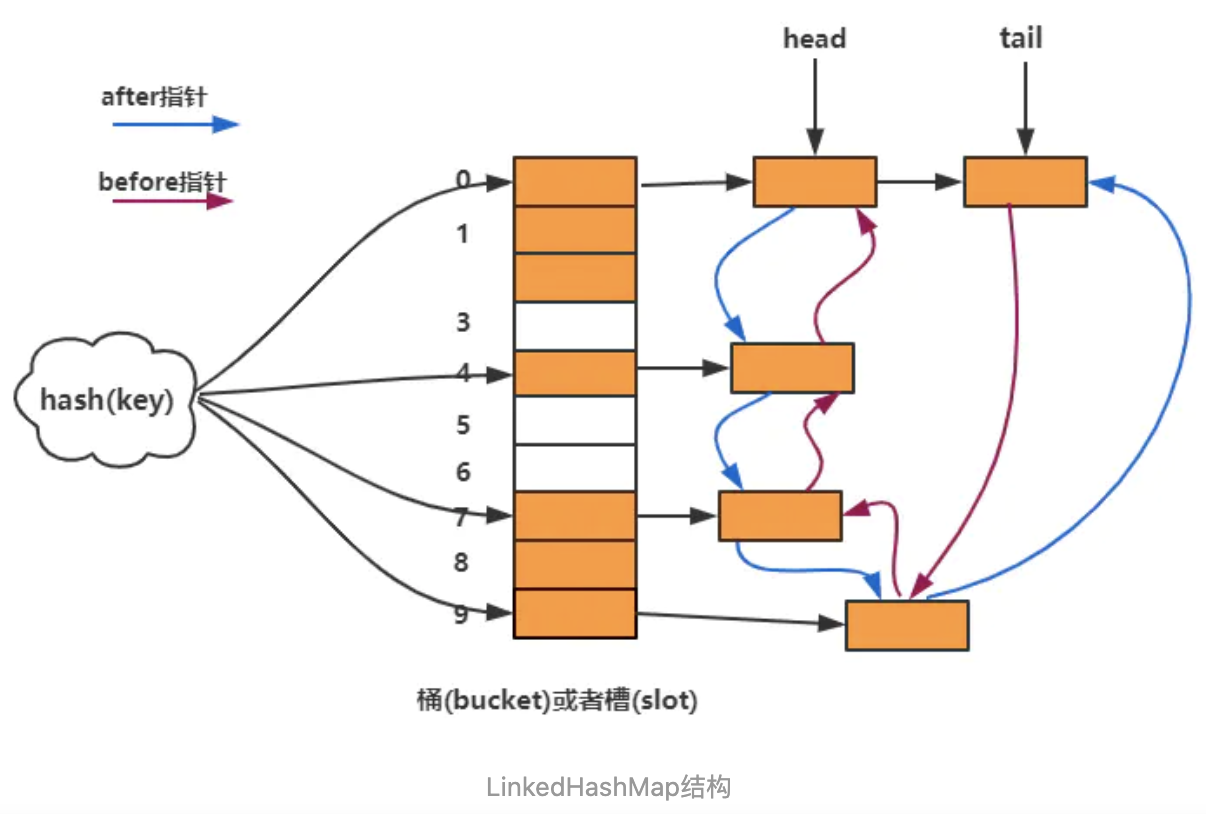TreeviewCopyright @doctording all right reserved, powered by aleen42
[TOC]
LinkedHashMap
HashMap + 双向链表

双向链表的定义
节点继承了HashMap.Node<K,V>,再加上双向链表的before节点和after节点
//扩展一个双向链表的entry
static class Entry<K,V> extends HashMap.Node<K,V> {
Entry<K,V> before, after;
Entry(int hash, K key, V value, Node<K,V> next) {
super(hash, key, value, next);
}
}
//链表头
transient LinkedHashMap.Entry<K,V> head;
//链表尾
transient LinkedHashMap.Entry<K,V> tail;
使用和说明
LinkedHashMap 的特性, 每个节点间由一个before引用 和 after 引用串联起来成为一个双向链表。链表节点按照访问时间进行排序,最近访问过的链表放在链表尾。
// 10 是初始大小,0.75 是装载因子,true 是表示按照访问时间排序
HashMap<Integer, Integer> m = new LinkedHashMap<>(10, 0.75f, true);
m.put(3, 11);
m.put(2, 12);
m.put(5, 23);
m.put(1, 22);
// 3 2 5 1
for (Map.Entry e : m.entrySet()) {
System.out.print(e.getKey() + " ");
}
System.out.println();
m.put(3, 26);
m.get(5);
// 2 1 3 5
for (Map.Entry e : m.entrySet()) {
System.out.print(e.getKey() + " ");
}
System.out.println();
get方法(类似LRU,不过最新访问的元素放到了链表最末尾)
会将当前被访问到的节点e,移动至内部的双向链表的尾部。
/**
* Returns the value to which the specified key is mapped,
* or {@code null} if this map contains no mapping for the key.
*
* <p>More formally, if this map contains a mapping from a key
* {@code k} to a value {@code v} such that {@code (key==null ? k==null :
* key.equals(k))}, then this method returns {@code v}; otherwise
* it returns {@code null}. (There can be at most one such mapping.)
*
* <p>A return value of {@code null} does not <i>necessarily</i>
* indicate that the map contains no mapping for the key; it's also
* possible that the map explicitly maps the key to {@code null}.
* The {@link #containsKey containsKey} operation may be used to
* distinguish these two cases.
*/
public V get(Object key) {
Node<K,V> e;
if ((e = getNode(hash(key), key)) == null)
return null;
if (accessOrder)
afterNodeAccess(e);
return e.value;
}
插入之后的removeEldestEntry方法(默认返回:false)
删除最久远的访问元素,LinkedHashMap默认直接返回false,即不会进行删除操作,可以重写该方法
/**
* Returns <tt>true</tt> if this map should remove its eldest entry.
* This method is invoked by <tt>put</tt> and <tt>putAll</tt> after
* inserting a new entry into the map. It provides the implementor
* with the opportunity to remove the eldest entry each time a new one
* is added. This is useful if the map represents a cache: it allows
* the map to reduce memory consumption by deleting stale entries.
*
* <p>Sample use: this override will allow the map to grow up to 100
* entries and then delete the eldest entry each time a new entry is
* added, maintaining a steady state of 100 entries.
* <pre>
* private static final int MAX_ENTRIES = 100;
*
* protected boolean removeEldestEntry(Map.Entry eldest) {
* return size() > MAX_ENTRIES;
* }
* </pre>
*
* <p>This method typically does not modify the map in any way,
* instead allowing the map to modify itself as directed by its
* return value. It <i>is</i> permitted for this method to modify
* the map directly, but if it does so, it <i>must</i> return
* <tt>false</tt> (indicating that the map should not attempt any
* further modification). The effects of returning <tt>true</tt>
* after modifying the map from within this method are unspecified.
*
* <p>This implementation merely returns <tt>false</tt> (so that this
* map acts like a normal map - the eldest element is never removed).
*
* @param eldest The least recently inserted entry in the map, or if
* this is an access-ordered map, the least recently accessed
* entry. This is the entry that will be removed it this
* method returns <tt>true</tt>. If the map was empty prior
* to the <tt>put</tt> or <tt>putAll</tt> invocation resulting
* in this invocation, this will be the entry that was just
* inserted; in other words, if the map contains a single
* entry, the eldest entry is also the newest.
* @return <tt>true</tt> if the eldest entry should be removed
* from the map; <tt>false</tt> if it should be retained.
*/
protected boolean removeEldestEntry(Map.Entry<K,V> eldest) {
return false;
}
使用LinkedHashMap实现一个LRU缓存(LeetCode)
class BaseLRUCache<K,V> extends LinkedHashMap<K,V> {
private int cacheSize;
public BaseLRUCache(int cacheSize) {
super(16,0.75f,true);
this.cacheSize = cacheSize;
}
/**
* 判断元素个数是否超过缓存容量
*/
@Override
protected boolean removeEldestEntry(Map.Entry<K, V> eldest) {
return size() > cacheSize;
}
}
class LRUCache {
BaseLRUCache<Integer, Integer> baseLRUCache;
public LRUCache(int capacity) {
baseLRUCache = new BaseLRUCache(capacity);
}
public int get(int key) {
if(baseLRUCache.get(key) == null){
return -1;
}
return baseLRUCache.get(key);
}
public void put(int key, int value) {
baseLRUCache.put(key, value);
}
}